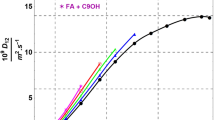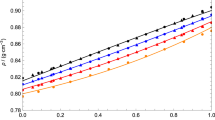Abstract
A cross-association model was proposed for CO2-alcohol mixtures based on the statistical associating fluid theory (SAFT). CO2 was treated as a pseudo-associating molecule and both the self-association between alcohol hydroxyls and the cross-association between CO2 and alcohol hydroxyls were considered. The equilibrium properties from low temperature-pressure to high temperature-pressure were investigated using this model. The calculated p-x and p-ρ diagrams of CO2-methanol and CO2-ethanol mixtures agreed with the experimental data. The results showed that when the cross-association was taken into account for Helmholtz free energy, the calculated equilibrium properties could be significantly improved, and the error prediction of the three phase equilibria and triple points in low temperature regions could be avoided.
Similar content being viewed by others
References
Jiang T, Han BX. Chemical thermodynamics of supercritical fluids (in Chinese). Prog Chem, 2006, 18: 657–669
Joung SN, Yoo CW, Shin HY, Kim SY, Yoo KP, Lee CS, Huh WS. Measurements and correlation of high-pressure VLE of binary CO2-alcohol systems (methanol, ethanol, 2-methoxyethanol and 2-ethoxyethanol). Fluid Phase Equilib, 2001, 185: 219–230
Chang CMJ, Chiu KL, Day CY. A new apparatus for the determination of P-x-y diagrams and Henry’s constants in high pressure alcohols with critical carbon dioxide. J Supercritical Fluids, 1998}, 12}: 223–
Zhu HG, Tian YL, Chen L, Feng JJ, Fu GF. Studies on vapor-liquid phase equilibria for SCF CO2 + CH3OH and SCF CO2 + C2H5OH systems (in Chinese). Chem Res Chin Univ, 2002, 23: 1588–1591
Tian YL, Han M, Feng JJ, Qin Y. Study on vapor-liquid phase equilibria for CO2-C2H5OH system (in Chinese). Acta Phys Chim Sinica, 2001, 17: 155–160
Secuianu C, Feroiu V, Geana D. Phase behavior for carbon dioxideethanol system: Experimental measurements and modeling with a cubic equation of state. J Supercritical Fluids, 2008, 47: 109–116
Galicia-Luna LA, Ortega-Rodriguez A, Richon D. New apparatus for the fast determination of high-pressure vapor-liquid equilibrium of mixtures and of accurate critical pressures. J Chem Eng Data, 2000, 45: 265–271
MendozadelaCruz JL, Galicia-Luna L. A High pressure vapor-liquid equilibrium for the carbon dioxide-ethanol and carbon dioxide-1-propanol systems at temperatures from 322.36 K to 391.96 K. ELDATA: Int Electron J Phys Chem Data, 1999, 5: 157–164
Lopez JA, Trejos VM, Cardona CA. Parameters estimation and VLE calculation in asymmetric binary mixtures containing carbon dioxide + n-alkanols. Fluid Phase Equilib, 2008, 275: 1–7
Polishuk I, Wisniak J, Segura H. Simultaneous prediction of the critical and sub-critical phase behavior in mixtures using equation of state I carbon dioxide-alkanols. Chem Eng Sci, 2001, 56: 6485–6510
Wang WL, Zhang XD, Liu XW, Xia YJ, Li ZY. Phase equilibria calculation for supercritical carbon dioxide and alcohol (in Chinese). J Chem Ind Eng, 2003, 24: 1–4
Chapman WG, Gubbins KE, Jackson G, Radosz M. SAFT equation of state solution model for associating fluids. Fluid Phase Equilib, 1989, 52: 31–38
Huang SH, Radosz M. Equation of state for small, large, polydisperse, and associating molecules. Ind Eng Chem Res, 1990, 2: 2284–2294
Chen J, Mi JG, Yu YM. An analytical equation of state for water and alkanols. Chem Eng Sci, 2004, 59: 5831–5838
Mi JG, Zhong CL, Li YG. Renormalization group theory for fluids including critical region I pure fluids. Chem Phys, 2004, 305: 37–45
Mi JG, Tang YP, Zhong CL. Prediction of global vapor-liquid equilibria for mixtures containing polar and associating components with improved renormalization group theory. J Phys Chem B, 2005, 109: 20546–20553
Mi JG, Zhong CL, Li YG. An improved renormalization group theory for real fluids. J Chem Phys, 2004, 121: 5372–5380
Mi JG, Zhong CL, Li YG. Renormalization group theory for fluids including critical region II binary mixtures. Chem Phys, 2005, 312: 31–38
Li XS, Wu HJ, Li YG. Hydrate dissociation conditions for gas mixtures containing carbon dioxide, hydrogen, hydrogen sulfide, nitrogen, and hydrocarbons using SAFT. J Chem Thermo, 2007, 39: 417–425
Li XS, Englezos P. Vapor-liquid equilibrium of systems containing alcohols, water, carbon dioxide and hydrocarbons using SAFT. Fluid Phase Equilib, 2004, 224: 111–118
Li XS, Wu HJ, Englezos P. Prediction of gas hydrate formation conditions in the presence of methanol, glycerol, ethylene glycol, and triethylene glycol with the statistical associating fluid theory equation of state. Ind Eng Chem Res, 2006, 45: 2131–2137
Li XS, Wu HJ, Feng ZP, Tang LG, Pang SS. Prediction of equilibrium hydrate formation conditions for gas mixtures using the statistical associating fluid theory equation of state (in Chinese). Acta Chim Sinica, 2007, 1: 59–66
Xu B, Li HR, Wang CM. Correlation of H-1 NMR chemical shift for aqueous solutions by statistical associating fluid theory association model. Chin J Chem Eng, 2005,13: 280–284
Fu D, Lu JF, Bao TZ, Li YG. Investigation of surface tension and interfacial tension in surfactant solutions by SAFT. Ind Eng Chem Res, 2000, 39: 320–327
Fu D, Lu JF, Liu JC, Li YG. Prediction of surface tension for pure non-polar fluids based on density functional theory. Chem Eng Sci, 2001, 56: 6989–6996
Lu JF, Fu D, Liu JC, Li YG. Application of density functional theory for predicting the surface tension of pure polar and associating fluids. Fluid Phase Equilib, 2002, 194-197: 755–769
Fu D, Li YG. Investigation of the phase equilibria for non-polar chainlike fluids by Yukawa potential and renormalization-group theory. Ind Eng Chem Res, 2004, 43: 2271–2279
Fu D, Zhao Y, Li YG. Investigation of the phase equilibria for pure associating fluids by Yukawa potential and renormalization group theory. Ind Eng Chem Res, 2004, 43: 5425–5429
Fu D. Study on vapor-liquid equilibria and surface tensions for nonpolar fluids by renormalization group theory and density gradient theory. J Phys Chem B, 2006, 110: 19575–19581
Button JK, Gubbins KE. SAFT prediction of vapour liquid equilibria of mixtures containing carbon dioxide and aqueous monoethanol amine or diethanol amine. Fluid Phase Equilib, 1999, 158–160: 175–181
Valtz A, Chapoy A, Coquelet C, Paricaud P, Richon D. Vapour-liquid equilibria in the carbon dioxide-water system, measurement and modelling from 278.2 to 318.2 K. Fluid Phase Equilib, 2004, 226: 333–344
Ji XY, Tan SP, Adidharma H, Radosz M. SAFT1-RPM approximation extended to phase equilibria and densities of CO2-H2O and CO2-H2O-NaCl systems. Ind Eng Chem Res, 2005, 44: 8419–8427
Li ZD, Firoozabadi A. Cubic-plus-association equation of state for water-containing mixtures: Is “cross association” necessary? AIChE J, 2009, 55: 1803–1813
Cotterman RL, Schwarz BJ, Prausnitz JM. Molecular thermodynamics for fluids at low and high densities, part (I) Pure fluids containing small and large molecules. AIChE J, 1986, 32: 1787–1798
Segura CJ, Chapman WG, Shukla KP. Associating fluids with four bonding sites against a hard wall: density functional theory. Mol Phys, 1997, 90: 759–771
Yu YX, Wu JZ. A Fundamental-measure theory for inhomogeneous associating fluids. J Chem Phys, 2002, 116: 7094–7103
Fu D, Li XS. Phase equilibria and plate-fluid interfacial tensions for associating hard sphere fluids confined in slit pores. J Chem Phys, 2006, 125: 084716
Beaton CF, Hewitt GF. Physical Property Data for the Design Engineer. New York: Hemisphere, 1989
Author information
Authors and Affiliations
Corresponding author
Rights and permissions
About this article
Cite this article
Fu, D., Yang, Z., Lu, J. et al. A cross-association model for CO2-methanol and CO2-ethanol mixtures. Sci. China Chem. 53, 1438–1444 (2010). https://doi.org/10.1007/s11426-010-3202-1
Received:
Accepted:
Published:
Issue Date:
DOI: https://doi.org/10.1007/s11426-010-3202-1




